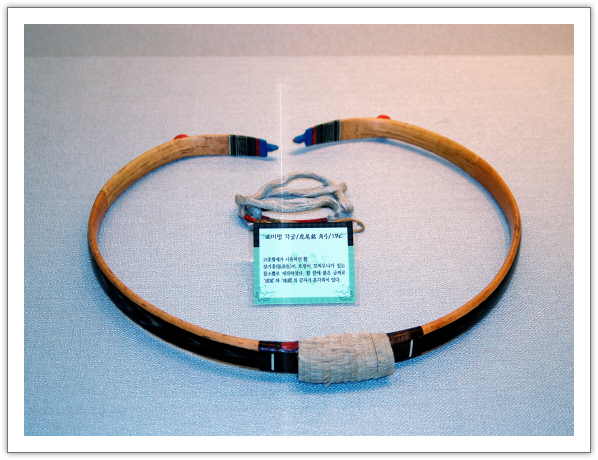- Gungdo
Infobox Korean name

caption=A Korean Bow (활, Hwal) that has not been strung
hangul=궁술
hanja=弓術
rr=Gungsul
mr=Kungsul
othername1=Korean bow
hangul1=국궁
hanja1=國弓
rr1=Gukgung
mr1=KukkungThe Korean Bow ('Hwal') is a waterbuffalo horn-based composite reflex bow, standardized about 1900 CE from the variety of such weapons in earlier use. It is normally used with a thumb draw.Gungsul, also written "goongsul", literally means "the Craft of the bow." It is also called
Korea n traditionalarchery .Historical use and decline
The bow had been the most important weapon in Korean wars with Chinese dynasties and nomadic peoples, recorded from the 1st century BCE. [ [http://www.atarn.org/korean/korean1.htm Korean Traditional Archery] ] Legend says the first king and founder of the
Goguryeo , Go Jumong, was a master of archery, able to catch 5 flies with one arrow. Park Hyeokgeose, the first king of theSilla , was also said to be a skilled archer. Rumours of archers in Goguryeo and Silla presumably reached China; the ancient Chinese gave the people of the north east, Siberia, Manchuria and the Korean Peninsula, the name 夷, which is the combination of 大(meaning "big") and 弓(meaning "bow").Until the
Japanese invasions of Korea (1592-1598) , archery was the main long-range weapon system. In that war, the tactical superiority of thematchlock musket became apparent, despite its slow rate of fire and susceptibility to wet weather. [Korean Traditional Archery. Duvernay TA, Duvernay NY. Handong Global University, 2007] Under King Hyojong's military reforms, an attempt was made to revivehorse archer y as a significant element of the military. This came to nothing after his sudden death in 1659, and there are no definite accounts of later military use of archery. Nevertheless, until the military reforms of 1894, archery was an essential part of the military examination. It was also practiced for pleasure and for health, and many young males - including the king - would spend their free time practicing it.Revival as leisure activity
In 1899, a visiting German prince expressed his astonishment to Emperor Gojong at a traditional archery demonstration. The emperor, impressed, decreed "let people enjoy archery to develop their physical strength" and established an archery club building. In the subsequent revival of Korean archery, the nature of the bow and the arrow was standardized, as was the range of the targets. Korean traditional archery now uses one specific type of
composite bow , bamboo arrows, and a standard target at a standard distance of 120 bo (about 145 meters).Construction and competition
The traditional Korean bow is a highly reflexed version of the classic Eurasian
composite bow . The core is bamboo, which is sinew backed, with oak at the handle. On the belly is waterbuffalo horn. The siyahs, the stiffened outer ends of the limbs, are made of either mulberry or black locust spliced (v-splice) onto the bamboo. The glue is made from fish air-bladder. Over the sinew backing is a special birch bark that is imported from Northeast China. It is soaked in sea water (possibly for one year). It is applied to the back using diluted rubber cement (using benzene as the solvent). No sights or other modern attachments are used.The draw weights vary, but most are above twenty kilograms. The cost for this type of bow is in the US$800 range. For a similar modern version made of laminated fiberglass, the cost is US$200-300. For most competitions, either bow may be used, with carbon-fiber arrows, but for national competitions, only the composite bow and bamboo arrows may be used. Korean archers have also been very successful in Olympic and other competitions with more modern types of bow. [cite web|title=South sweep|url=http://sportsillustrated.cnn.com/olympics/2000/archery/news/2000/09/18/skorea_archery/|date=2000-09-28|accessdate=2008-03-16|publisher=
Sports Illustrated ]The sukgung, a kind of
crossbow , is a small but very powerful bow. A sukgung can shoot up to 400 meters.ee also
*
Composite bow
*Hungarian bow
*Turkish bow
*Mongol bow
*Myeonggung (名弓, Bow Master)
*Pyeonjeon (片箭, Tiny Arrow - Special Weapon)
*Singijeon (神機箭, Multi Missile)References
External links
* [http://www.koreanarchery.org Korean Traditional Archery]
* [http://steppenreiter.de/korea.htm The Way of the Bow]
* [http://www.archerynews.com/ Korean Archery News (Korean)]Further reading
Korean Traditional Archery. Duvernay TA, Duvernay NY. Handong Global University, 2007.
Wikimedia Foundation. 2010.
